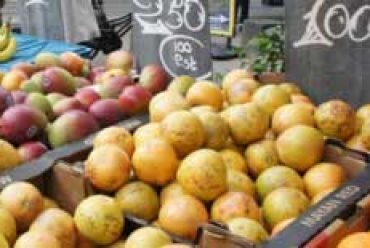Halloween’s Surprising Impacts

By Julie Starkel and Aliya Hirji
Whenever Halloween approaches, the subject of costumes and candy likely comes up in conversation. It’s exciting to dress up as someone or something from our dreams for a night. However, some parents dread the inevitable sugar overload that follows We know about the dangers of sugar. But if we also knew more about the impact that candy ingredients have on the environment, we might look for alternatives.
Green Halloween is a nonprofit, grassroots community movement to create healthier and more Earth-friendly holidays and provide healthier treats to tantalize our kids. Halloween is their first target. To explore this thought a bit more, let’s look at some nutrition information of candy and its impact on health and the environment.
An example, I picked the Milky Way bar to observe closer. Out of its 20 ingredients, the top three are different forms of sugar. Milky Way also includes partially hydrogenated soybean oil, a transfat that also increases inflammation in the body. It also contains several forms of wheat, which is not harmful for many, but can be for people with gluten intolerance or Celiac disease.
The Milky Way label lists 0 g trans fat. How can this be true when a major ingredient is partially hydrogenated soybean oil, a trans fat? U.S. labeling laws state that if there are less than 0.5 grams of trans fat per serving, food manufacturers may label it as 0 grams. Here’s the catch: If you eat more than two bars, you are starting to accumulate your intake of trans fat. Again, this is an artificial substance that has negative health effects. There are 20 grams of sugar in two bars. As a comparison, there are 17 grams of unrefined sugar in a medium pear. But a pear also has fiber, antioxidants, vitamins, and minerals—just a whole lot more nutrition. Milky Way is low in nutrients and high in low-quality ingredients.
The impact of eating candy on our health is cumulative. One bar won’t kill you, of course, but over time, eating a few a day make an impact in various ways.

- Weight gain. We need to eat only 500 extra calories a day to gain one pound in a week, and one pound per week is 52 pounds per year! Two regular-size Milky Way bars or six and a half fun-size bars per day add up to 500 calorie with very few real nutrients.
- Dental caries. High-sugar foods contribute to tooth cavities. Recent research indicates that the health of teeth is related to overall health.
- Some children do not handle sugar well. You have seen the tantrums or crazy energy erupt from a child who has recently consumed a significant quantity of sugar.
- Eating a lot of sugar (glucose) is a potential future diagnosis of diabetes. When we eat sugar alone, without accompanying it with protein and/or high-quality fat, our blood-sugar levels spike. This releases large amounts of insulin into our blood. Over time our beta cells, the cells that produce insulin, can “wear out” reducing our body’s cells’ ability to absorb glucose.
- None of the popular candies are organic, which means our children are consuming synthetic pesticides and fertilizers.
Surprising Environmental Impacts
 Due to the nature of their production and abundant use of low-quality, highly processed ingredients, junk food tends to have an effect on the environment. Corn syrup or high-fructose corn syrup, used to sweeten many processed foods, comes from corn. Much of the corn grown today is genetically modified. Whatever your belief on the topic of genetically modified foods, we know it is changing our environment toward a future we cannot predict. In addition, the increase in farmland use for planting corn is depleting our soil of nutrients. Corn is relatively low on the nutrient density scale, so its value is limited, other than for corn syrup, livestock feed, or ethanol.
Due to the nature of their production and abundant use of low-quality, highly processed ingredients, junk food tends to have an effect on the environment. Corn syrup or high-fructose corn syrup, used to sweeten many processed foods, comes from corn. Much of the corn grown today is genetically modified. Whatever your belief on the topic of genetically modified foods, we know it is changing our environment toward a future we cannot predict. In addition, the increase in farmland use for planting corn is depleting our soil of nutrients. Corn is relatively low on the nutrient density scale, so its value is limited, other than for corn syrup, livestock feed, or ethanol.
Because of unsustainable farming practices, our American farmland has been depleted of nutrients, causing farmers to use more fertilizers and pesticides to achieve profitable yields. These fertilizers and pesticides run off the farms into our waterways. The huge algae explosion in the Caribbean is largely a result of the non-organic farming practices in the Midwest, where the bulk of commodity foods such as corn, sugar, and other grains are grown.

Milk is also commonly used in candy bars. The bovine growth hormone rBGH is abundant in our dairy source. Drugs and chemicals used in livestock raising practices can end up in our water and food supply. Milk production in this country demands the use of corn, since cows are fed corn, although they are meant to eat grass. These and other livestock raising practices pollute the environment with potentially toxic substances from the excrement of the cows and methane gas released into the air.
The good news is that alternatives are available. We encourage you to search the Internet for alternatives to conventional candy for Halloween. There are a ton of ideas out there!
Julie Starkel, MS, MBA, RD is a whole foods Clinical Nutritionist and Registered Dietitian, who sees clients at Green Lake Nutrition, located in Kirkland and Seattle, Washington. She has a Master of Science degree in Nutrition from Bastyr University and a background of over 10 years in health and fitness. She’s a member of the American Dietetic Association, the Nutrition in Complementary Care dietetic practice group, the Institute of Functional Medicine, and has worked in both the traditional and natural medicine arenas in Chicago and Seattle.
See her website, e-mail her, or call 206-465-3469.
Aliya Hirji received her Bachelor of Science degree in Nutrition from Bastyr University. She has been involved in managing Living Montessori’s food program since 2003. You may contact her by e-mail.
Contact us today for more information about the fun alternatives that Living Montessori provides to unhealthy Halloween traditions.







